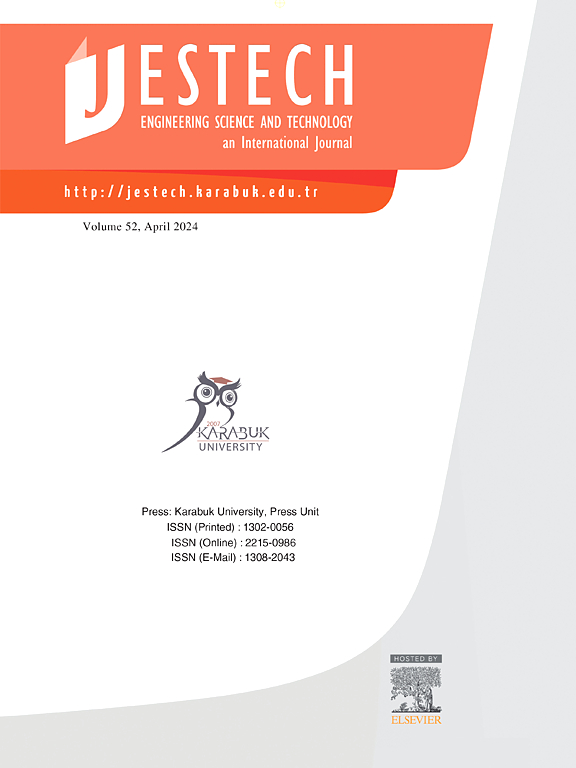LightYOLO:基于 YOLOv8n 的轻量级模型,用于超声波焊接电线终端的缺陷检测
IF 5.1
2区 工程技术
Q1 ENGINEERING, MULTIDISCIPLINARY
Engineering Science and Technology-An International Journal-Jestech
Pub Date : 2024-11-22
DOI:10.1016/j.jestch.2024.101896
引用次数: 0
摘要
超声波焊接焊丝终端表面的缺陷检测是确保焊接质量的重要检测程序。然而,基于深度学习的超声波焊接缺陷检测任务仍然面临着检测精度低、推理速度慢的挑战。因此,为了解决上述问题,我们提出了一种基于 You Only Look Once v8(YOLOv8n)的快速有效的轻量级检测模型,命名为 LightYOLO。具体来说,首先,为了实现快速特征提取,我们在骨干网络中引入了具有 FasterNet block 和 Efficient multi-scale attention (CTFE) 结构的 Two-Convolution 模块。其次,利用组卷积(GSConv)构建颈部特征融合结构,提高了多级特征的融合效率。最后,引入辅助头部训练方法,提取网络的浅层细节。为了验证所提方法的有效性,我们构建了超声波焊丝端子表面缺陷数据集,并进行了一系列实验。实验结果表明,LightYOLO 的精度为 93.4%,比 YOLOv8n(89.9%)高出 3.5%。此外,模型大小减少到基线模型的 1/2。LightYOLO显示了在边缘计算设备上进行快速检测的潜力。我们项目的源代码和数据集可在 https://github.com/JianshuXu/LightYOLO 上查阅。本文章由计算机程序翻译,如有差异,请以英文原文为准。
LightYOLO: Lightweight model based on YOLOv8n for defect detection of ultrasonically welded wire terminations
Defect inspection of the surface in ultrasonically welded wire terminations is an important inspection procedure to ensure welding quality. However, the detection task of ultrasonic welding defects based on deep learning still faces the challenges of low detection accuracy and slow inference speed. Therefore, to solve the above problems, we propose a fast and effective lightweight detection model based on You Only Look Once v8 (YOLOv8n), named LightYOLO. Specifically, first, to achieve fast feature extraction, a Two-Convolution module with FasterNet block and Efficient multi-scale attention (CTFE) structures is introduced in the backbone network. Secondly, Group-Shuffle Convolution (GSConv) is used to construct the feature fusion structure of the neck, which enhances the fusion efficiency of multi-level features. Finally, an auxiliary head training method is introduced to extract shallow details of the network. To verify the effectiveness of the proposed method, we constructed a surface defect data set of ultrasonic welding wire terminals and conducted a series of experiments. The results of experiments show that the precision of LightYOLO is 93.4%, which is 3.5% higher than YOLOv8n(89.9%). In addition, the model size was reduced to 1/2 of the baseline model. LightYOLO shows the potential for rapid detection on edge computing devices. The source code and dataset for our project is accessible at https://github.com/JianshuXu/LightYOLO.
求助全文
通过发布文献求助,成功后即可免费获取论文全文。
去求助
来源期刊

Engineering Science and Technology-An International Journal-Jestech
Materials Science-Electronic, Optical and Magnetic Materials
CiteScore
11.20
自引率
3.50%
发文量
153
审稿时长
22 days
期刊介绍:
Engineering Science and Technology, an International Journal (JESTECH) (formerly Technology), a peer-reviewed quarterly engineering journal, publishes both theoretical and experimental high quality papers of permanent interest, not previously published in journals, in the field of engineering and applied science which aims to promote the theory and practice of technology and engineering. In addition to peer-reviewed original research papers, the Editorial Board welcomes original research reports, state-of-the-art reviews and communications in the broadly defined field of engineering science and technology.
The scope of JESTECH includes a wide spectrum of subjects including:
-Electrical/Electronics and Computer Engineering (Biomedical Engineering and Instrumentation; Coding, Cryptography, and Information Protection; Communications, Networks, Mobile Computing and Distributed Systems; Compilers and Operating Systems; Computer Architecture, Parallel Processing, and Dependability; Computer Vision and Robotics; Control Theory; Electromagnetic Waves, Microwave Techniques and Antennas; Embedded Systems; Integrated Circuits, VLSI Design, Testing, and CAD; Microelectromechanical Systems; Microelectronics, and Electronic Devices and Circuits; Power, Energy and Energy Conversion Systems; Signal, Image, and Speech Processing)
-Mechanical and Civil Engineering (Automotive Technologies; Biomechanics; Construction Materials; Design and Manufacturing; Dynamics and Control; Energy Generation, Utilization, Conversion, and Storage; Fluid Mechanics and Hydraulics; Heat and Mass Transfer; Micro-Nano Sciences; Renewable and Sustainable Energy Technologies; Robotics and Mechatronics; Solid Mechanics and Structure; Thermal Sciences)
-Metallurgical and Materials Engineering (Advanced Materials Science; Biomaterials; Ceramic and Inorgnanic Materials; Electronic-Magnetic Materials; Energy and Environment; Materials Characterizastion; Metallurgy; Polymers and Nanocomposites)
 求助内容:
求助内容: 应助结果提醒方式:
应助结果提醒方式:


